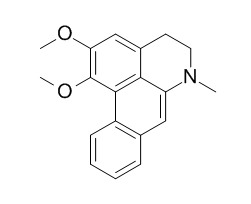Dehydronuciferine
Dehydronuciferine shows inhibitory of acetylcholinesterase with the IC50 of 25 ug/mL.
Inquire / Order:
manager@chemfaces.com
Technical Inquiries:
service@chemfaces.com
Tel:
+86-27-84237783
Fax:
+86-27-84254680
Address:
1 Building, No. 83, CheCheng Rd., Wuhan Economic and Technological Development Zone, Wuhan, Hubei 430056, PRC
Providing storage is as stated on the product vial and the vial is kept tightly sealed, the product can be stored for up to
24 months(2-8C).
Wherever possible, you should prepare and use solutions on the same day. However, if you need to make up stock solutions in advance, we recommend that you store the solution as aliquots in tightly sealed vials at -20C. Generally, these will be useable for up to two weeks. Before use, and prior to opening the vial we recommend that you allow your product to equilibrate to room temperature for at least 1 hour.
Need more advice on solubility, usage and handling? Please email to: service@chemfaces.com
The packaging of the product may have turned upside down during transportation, resulting in the natural compounds adhering to the neck or cap of the vial. take the vial out of its packaging and gently shake to let the compounds fall to the bottom of the vial. for liquid products, centrifuge at 200-500 RPM to gather the liquid at the bottom of the vial. try to avoid loss or contamination during handling.
Plants (Basel).2021, 10(4):702.
The Japan Society for Analytical Chemistry2018, 67(4):201-206
Anal Bioanal Chem.2018, 410(5):1561-1569
Metabolites.2023, 13(6):689.
Biol. Life Sci. Forum2024, 35(1), 6.
Planta Med.2016, 82(13):1208-16
J Adv Res.2021, 35:245-257.
LWT2021, 147:111620.
Applied Biological Chemistry2023, 66:42.
Nat Commun.2019, 10(1):5169
Related and Featured Products
Zhongguo Zhong Yao Za Zhi. 2013 Mar;38(5):703-8.
Chemical constituents from leaves of Nelumbo nucifera.[Pubmed:
23724680]
To study the chemical constituents, twenty-seven compounds were isolated from the 70% ethanol extract from leaves of Nelumbo nucifera by modern chromatographic techniques.
METHODS AND RESULTS:
Their structures were identified as 10-octacosanol (1), beta-sitosterol (2), 1-undecanol (3), 1-eicosanol (4), daucosterol (5), 6'-hydroxy-4,4'-dimethoxychalcone (6), 3,7,8-trimethoxy-1-hydroxy-xanthone (7), rhamnetin-3-O-beta-D-glucopyranoside (8), chrysoeriol-7-O-beta-D-glucoside (9), quercetin-3-O-beta-D-glucopyranoside (10), quercetin-3-O-alpha-L-rhamnopyranosyl (11), hyperoside (12), quercetin-3-O-rutinoside (13), astragalin (14), isorhamnetin-3-O-alpha-L-rhamnopyranosyl-(1--> 6)-[alpha-D-lyxopyranosyl-(1 --> 2) -beta-D-glucopyranoside] (15), isorhamnetin-3-O-alpha-D-lyxopyranosyl-(1 --> 2) -beta-D-glucopyranoside (16), isorhamnetin-3-O-beta-D-glucopyranoside (17), isorhamnetin-3-O-alpha-L-rhamnopyranosyl-(1 --> 6)-beta-D-glucopyranoside (18), quercetin (19), kaempferol (20), Dehydronuciferine (21), roemerine (22), stigmast-7-en-3-O-beta-D-glucopyranoside (23), stigmast-7-en-3beta-ol (24), and benzene-1,2-diol (25) on the basis of spectral data analysis.
CONCLUSIONS:
Compounds 1, 6, 7, 8, 24 and 25 were isolated from this plant for the first time, and compounds 15-18 were isolated from the leaves for the first time. Compounds 6, 8, 10, 11, 13 and 15 showed inhibitory activities against beta amyloid (1-42) by A-beta aggregation method with inhibition rates of (63.99 +/- 24.29)%, (79.61 +/- 4.49)%, (49.96 +/- 12.61)%, (101.19 +/- 8.19)%, (88.41+/-6.76)% and (72.48 +/- 8.97)%, respectively.
Medicinal Chemistry Research, 2014, 23(6):3178-3186.
Synthesis and structure-Activity relationship of nuciferine derivatives as potential acetylcholinesterase inhibitors[Reference:
WebLink]
Acetylcholinesterase inhibitors (AChEIs) are currently the best available pharmacotherapy for Alzheimer patients, but because of bioavailability issues, there is still great interest in discovering better AChEIs. The aporphine alkaloid is an important class of natural products, which shows diverse biological activity, such as acetylcholinesterase inhibitory activity.
METHODS AND RESULTS:
To find new lead AChEIs compounds, eight aporphine alkaloids were synthesized by O-dealkylation, N-dealkylation, and ring aromatization reactions using nuciferine as raw material. The anti-acetylcholinesterase activity of synthesized compounds was measured using modified Ellman’s method. The results showed that some synthesized compounds exhibited higher affinity to AChE than the parent compound nuciferine. Among these compounds, 1,2-dihydroxyaporphine (2) and Dehydronuciferine (5) were the most active compounds (IC50 = 28 and 25 μg/mL, respectively).
CONCLUSIONS:
Preliminary analysis of structure–activity relationships suggested that aromatization of the C ring, the presence of the alkoxyl group at C1 and the hydroxy group at C2 position as well as the alkyl substituent at the N atom were favorable to the acetylcholinesterase inhibition. Molecular docking was also applied to predict the binding modes of compounds 1, 2, and 9 into the huperzine A binding site of AChE.
3,3',4',5,6,7,8-heptamethoxyflavone
Catalog No: CFN95021
CAS No: 1178-24-1
Price: $268/10mg
Ganoderic acid L
Catalog No: CFN95022
CAS No: 102607-24-9
Price: $413/5mg
Polygalasaponin XLIX
Catalog No: CFN95117
CAS No: 1033593-12-2
Price: $318/10mg
Eucomic acid
Catalog No: CFN95364
CAS No: 42151-32-6
Price: $368/5mg
Platycodin J
Catalog No: CFN95395
CAS No: 1325614-80-9
Price: $318/5mg
1,3,4,6-Tetragalloylglucose
Catalog No: CFN95425
CAS No: 26922-99-6
Price: $318/10mg
Gambogoic acid A
Catalog No: CFN95439
CAS No: 887923-49-1
Price: $318/10mg
Oleracein E
Catalog No: CFN95441
CAS No: 1021950-79-7
Price: $318/5mg
Oxytroflavoside E
Catalog No: CFN95464
CAS No: 1391144-84-5
Price: $318/5mg
Isorhamnetin 3,5-O-diglucoside
Catalog No: CFN95488
CAS No: 2035413-03-5
Price: $318/10mg



